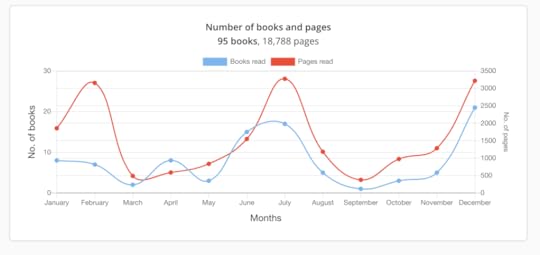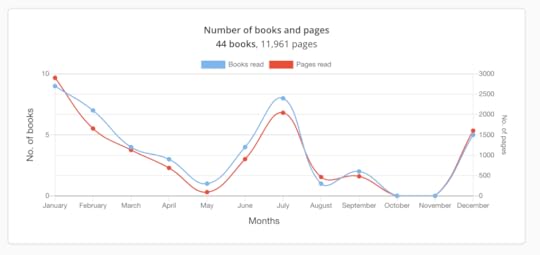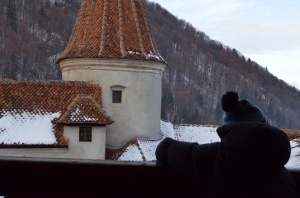Books I Read in 2021, Part 1
Jeesh, January will be over soon, so I better get on my annual blog post!
After a miserably light reading year in 2020, I was determined to make 95 books in 2021, but I could see right away that it would be an issue given how exhausted I was between pandemic-work, pandemic-family, and pandemic-buying-and-selling-houses-and-moving. So I decided early on that I’d also read, and count, chapbooks in my total. So, I only sort of read 95 books—and I barely made it even so.
I also set a “page goal” in the app I’m using – The StoryGraph – just so I could see how close I was to reading an “average” 200-page book. I didn’t quite make the page count, but it was close. On average, a “book” for me was just under 200 pages. Not bad considering all the chapbooks of less than 20 pages I read! There were a few doozies in there that balanced it out.
Check out this neat graph you can get on The StoryGraph:

It’s my reading pattern for the year! You’ll note the same general pattern in 2020, although with thousands fewer pages:

What are those dips and rises? The dips are the school term. The rises are summer and Christmas breaks.
Without further ado (have I written this like a recipe blogger?), here are my most memorable books of 2021! It was hard to choose this year, so I went long with a list of 10 – well, 11, because I couldn’t decide between the Patti Smith books. Remember that my list is whimsical and reflects how the mood strikes me as I write this. It’s not a best-of!
Some close runners-up that I won’t talk about: The Baudelaire Fractal by Lisa Robertson; Disorientation: Being Black in the World by Ian Williams; The Lightning of Possible Storms by Jonathan Ball; Here the Dark by David Bergen; Heteroskeptical by Marcus McCann; The Talented Mr. Ripley by Patricia Highsmith; The City We Became by N.K. Jemisin; St. Mary at Main by Patrick Friesen; The Perfect Nanny by Leila Slimani.
Dracula by Bram StokerI had never read this before, and I read it aloud to my daughter over a period of months. We laughed a lot at how obtuse the characters are, how they really needed to treat Mina with more respect, and, especially, at how much Van Helsing talks in his semi-comprehensible babble. All and all well worth reading to see what all the fuss is about. We especially appreciated all the Transylvanian landscape and people, having been there a few years ago and visited one of the castles purported to be related to the Dracula legend (my vacation photo below).
 Bran CastleThe Centaur’s Wife by Amanda Leduc
Bran CastleThe Centaur’s Wife by Amanda LeducA good companion piece to her also excellent nonfiction book Disfigured: On Fairy Tales, Disability, and Making Space (which I also read this year), Leduc has written a fairy-tale-esque novel centring on human characters with disabilities and fantastic characters with nonhuman qualities, all set in a world where the earth itself is consciously taking revenge on humanity. What sticks in my mind most is the harrowing mid-point climax (which I won’t give away…).
Klara and the Sun by Kazuo IshiguroYou know I’ve been teaching basic story structure too long when I keep getting excited about mid-point climaxes. Klara and the Sun is a quiet book with a strangely meditative quality stemming from the voice of its narrator, Klara, an android programmed to be devoted to a lonely human teenager. I was hit hard by the quiet but central reveal about her host family’s motivations. I didn’t like this book as much as my favourite Ishiguro (Never Let me Go, which I’m guessing is a lot of peoples’ favourite), but this was a satisfyingly Ish-y experience.
More memorable books in another post soon!



